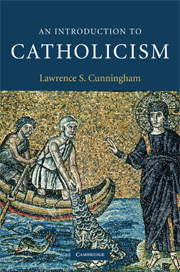Book contents
- Frontmatter
- Contents
- Illustrations
- Preface
- Acknowledgments
- 1 The many meanings of Catholicism
- 2 Roman Catholicism
- 3 Being Catholic: Some typologies
- 4 Catholicism in place and time
- 5 Catholic worship
- 6 The rule of faith
- 7 Catholic spirituality
- 8 The missionary character of Catholicism
- 9 Catholic reformation(s)
- 10 The moral life
- 11 The contemporary Catholic Church
- 12 Reading Catholicism: Bibliographical resources
- Index
- References
4 - Catholicism in place and time
Published online by Cambridge University Press: 05 June 2012
- Frontmatter
- Contents
- Illustrations
- Preface
- Acknowledgments
- 1 The many meanings of Catholicism
- 2 Roman Catholicism
- 3 Being Catholic: Some typologies
- 4 Catholicism in place and time
- 5 Catholic worship
- 6 The rule of faith
- 7 Catholic spirituality
- 8 The missionary character of Catholicism
- 9 Catholic reformation(s)
- 10 The moral life
- 11 The contemporary Catholic Church
- 12 Reading Catholicism: Bibliographical resources
- Index
- References
Summary
INTRODUCTION
The Catholic Church as an empirical reality is, at one level, a place that can be identified: For example, “That is a Catholic church on the other side of the street.” Before we enter into a further discussion of what Catholics believe and how they worship, it might be instructive to think about the “where” of Catholicism not in a universal sense but as the Church makes itself manifest locally. In a sense, we will attempt to answer the empirical questions: Where is the Catholic Church? Can you point me to that church? The thesis of this chapter is that if someone actually looks at the place where Catholic believers gather, both historically and actually, one can learn a good deal about Catholic practice and belief. That thesis will first lead us, for a short space, into the area of architecture. The history of Christian church architecture is, obviously, a highly complex one, but we at least sketch out a broad outline that will be of service to discussions that will take place in later chapters. We shall discuss a few historical examples of the evolution of floor plans of Catholic churches to see how the changing shape of churches reflect a widening of Catholic belief and practice.
In this chapter, then, we will focus not on the assembly of Catholic Christians (which is the ekklesia) but where they gather, which is in what generally we call the church.
- Type
- Chapter
- Information
- An Introduction to Catholicism , pp. 75 - 99Publisher: Cambridge University PressPrint publication year: 2009



